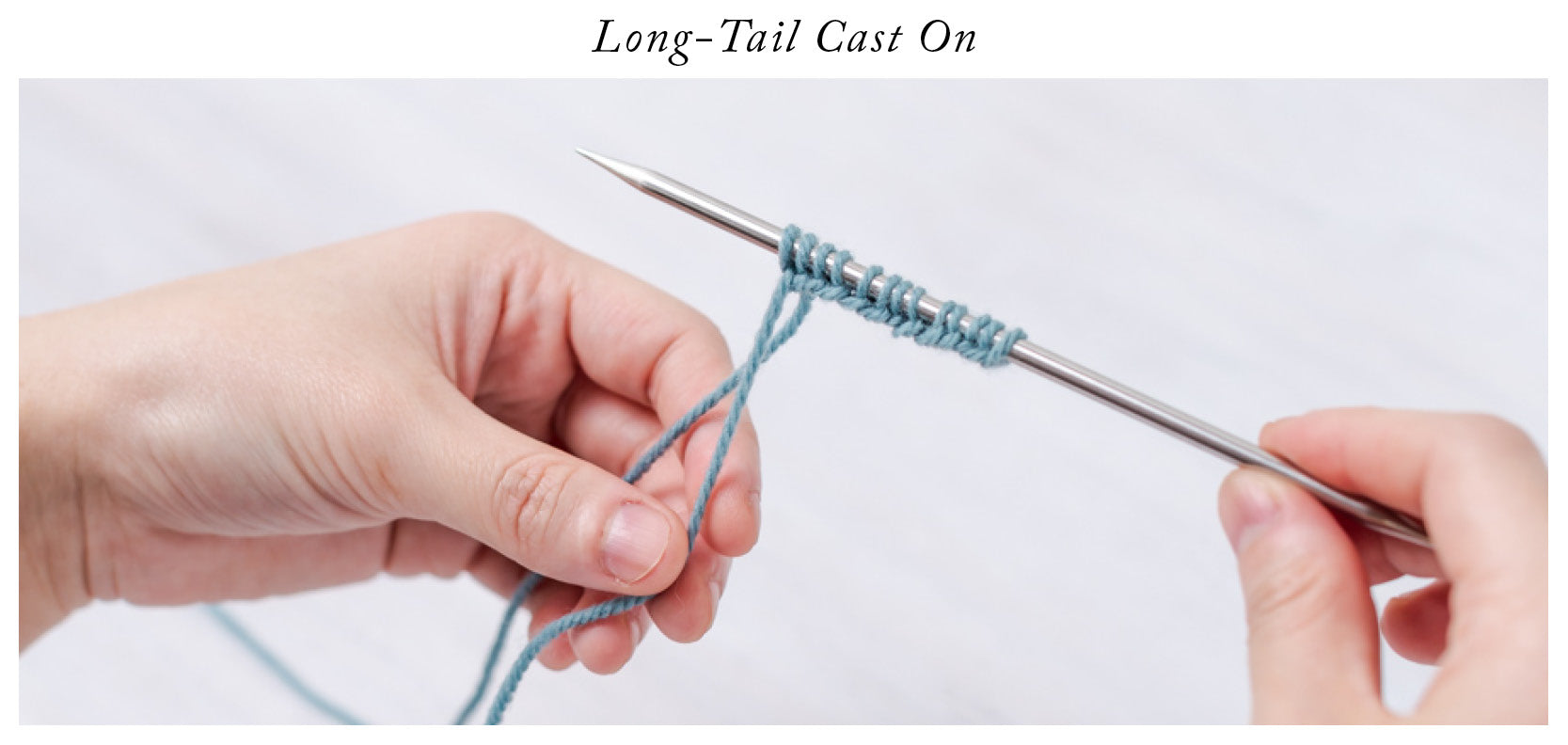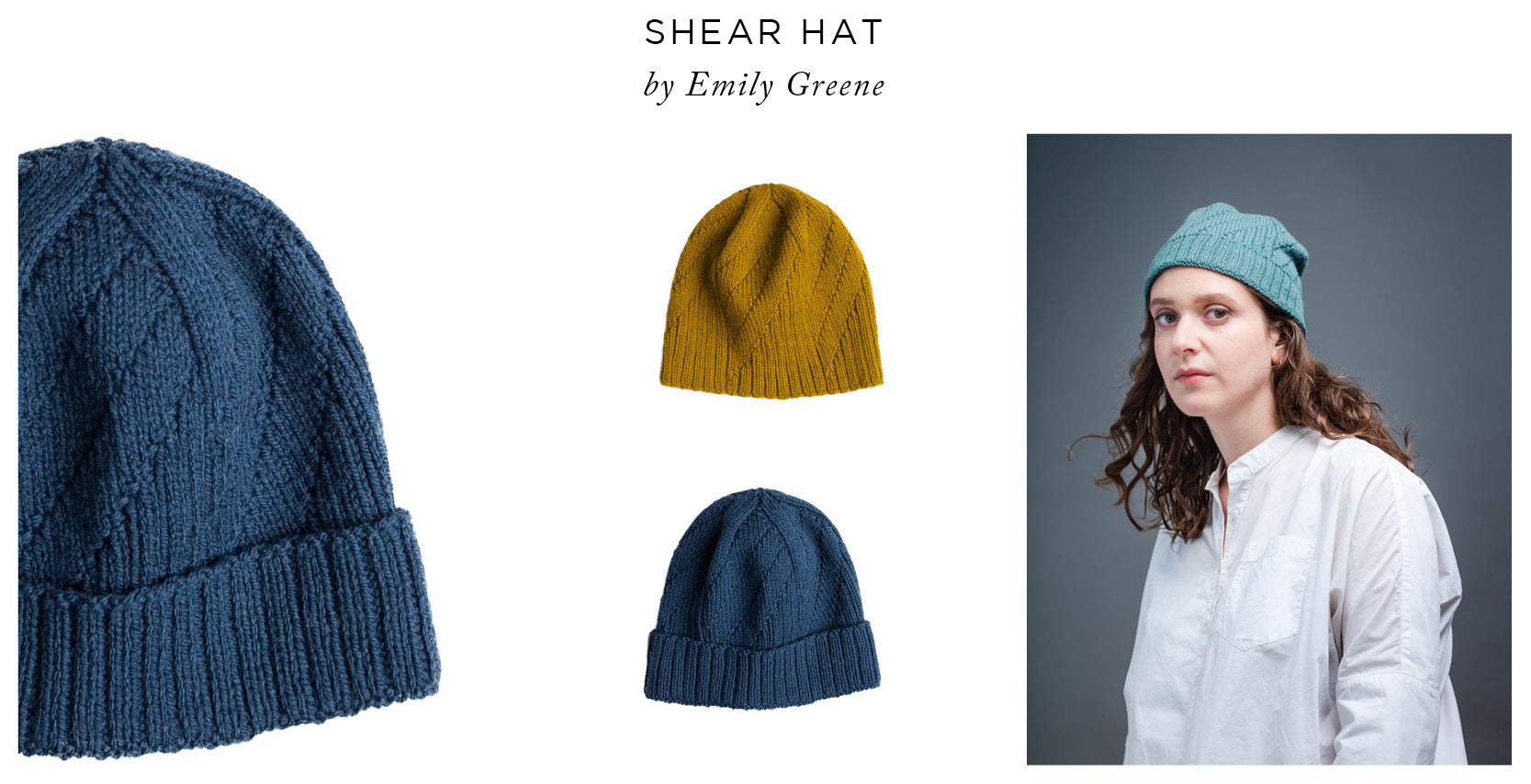There is perhaps nothing more foundational than a neat and utilitarian cast on method — after all, it is what begins your piece of knitting!
If you find this tutorial helpful, we’d love your support!
Shop our breed-specific American wool yarns & thoughtfully designed patterns.
There are numerous methods to cast on stitches and each method creates different kinds of foundational edges that are suited for similarly different kinds of fabrics. There are methods that create a sturdy edge that prevents flaring and methods that are both durable and elastic, perfect for projects (like hats and socks) that need a good amount of stretch while still being fitted on the body.
Part of growing into your craft is learning multiple cast on methods and discovering which ones work best for you, your process of knitting, and the finished results that you hope to achieve with each project.
Here, we’ll show you how to work the dependable (and ubiquitous!) Long-Tail Cast On, as well as two of our favorites for beginning 1×1 ribbed fabrics: the Ribbed Cable Cast On and the Tubular Cast On.

The Long-Tail Cast On is a two-strand cast on and is many a knitter’s preferred method of casting on because it’s strong, elastic, and quite versatile. Generally, it’s worked on one of your two needles first and requires two strands of yarn: the working yarn (coming off of the ball) and what would become the tail end of the yarn after the first cast on stitch (hence its name, Long-Tail).
Step 1. Pull your required length of yarn.

Tip: Wrap your yarn around your needle until you have an amount of wraps equal to the amount of stitches you need to cast on in order to approximate how long your tail end should be. For example, for 10 stitches, wrap the yarn around 10 times, then include a few inches extra, just in case.
Step 2. Drape your yarn over the right (R) needle, with the tail end in the front. Hold the yarn steady on the needle with your right index finger. In your left hand, tension both strands so that they are taut between your middle and ring finger.
Step 3. While keeping the yarn sandwiched in your left hand, insert your left index finger and thumb between the lengths of yarn and separate them — your index finger should be pushing against the working yarn behind and your thumb should be pushing against the tail end of the yarn in the front.
Step 4. Pivot your left hand away from you and your right hand (with your index finger keeping the yarn in place on the needle) toward your left palm. You should have a loose loop wrapping around your left thumb and a loose loop wrapping around your left index finger.

Tip: We prefer not to use a slip knot with the Long-Tail cast on, which creates a bump at the beginning of the cast on row. If you prefer to use a slip knot, do so at the beginning of Step 2, omitting the need to drape the yarn over the right needle.
Step 5. With the needle in your right hand, insert it into the strand in front of the thumb and through the loop from left to right by maneuvering under the strand in front of the thumb, then catch the strand over the index finger on the side in front of the finger by bringing the needle over.

Note: At this point, you’ll have 3 loops on your needle: the one held in place by your right index finger, the one coming off your thumb (tail end), and the one coming off your left index finger (working yarn).
Step 6. Pull the working yarn through the loop on your left thumb.
Step 7. Remove your left thumb from the loop and tug on the yarn (tail end) to secure the loop formed by the working yarn — snugly, but not too tightly!

Note: You’ll now have 2 stitches on your needle: the one you held in place with your right index finger and the stitch you just created.
Repeat Steps 3-7 until you’ve cast on all the stitches you need.
At the end, you should have a nice cast on edge. Next, simply turn and begin your work, or join to work in the round if working circularly (take care not to twist your cast on row!). Practice this technique with the Shear Hat by Emily Greene.

If you’d like more elasticity and a visual finish that transitions nicely into your 1×1 knit and purl columns, the 1×1 Ribbed Cable Cast On is a good option to try. To work it, it requires both your knitting needles and one strand of yarn. It also falls under the category of knitted cast ons, and you’ll soon see why!
Step 1. Begin with a slip knot on your left (L) needle. Leave a tail long enough to weave in later.

Step 2. Insert your right (R) needle into the slip knot as if to knit and knit a new stitch. Place the new stitch onto the L needle. Don’t tug to tighten just yet — keep the stitch slack.

Note: This stitch you’ve just created from the slip knot is a knit stitch. You’re now going to alternate between casting on purl stitches and casting on knit stitches. The 1×1 Ribbed Cable Cast On method may be reversed by first purling into the slip knot, then alternating knit and purl cast on stitches.
Step 3 (Casting On a Purl Stitch). Insert your R needle from behind the L needle between the first and second stitch on the L needle. (Now you can pull on your working yarn so it’s snug.) Wrap your yarn around the R needle as you would for a purl stitch and pull through. Place this new loop onto the L needle. As before, don’t tug to tighten just yet — keep the stitch slack.

Here’s what your needle placement will look like to cast on a purl stitch:

Step 4 (Casting On a Knit Stitch). Insert R needle from the front between the first and second stitch on the L needle. (Now you can pull on your working yarn so it’s snug.) Wrap the yarn around the R needle as you would for a knit stitch and pull through. Place the loop onto the L needle.

Tip: If you hold the working yarn continental-style (in the left hand), be sure to bring the yarn around to the front for a purl stitch or around to the back for a knit stitch, before inserting the R needle between the stitches.
Here’s what your needle placement will look like to cast on a knit stitch:

Repeat Steps 3 and 4 until your required number of stitches have been cast on, ending with a purl stitch if casting on an odd number of stitches.
Step 5. If the last stitch you cast on is a knit stitch, slip the last stitch purlwise to the R needle. Bring the working yarn to the front between your needles, then return the last stitch to the L needle. Pull the working yarn snugly.
If the last stitch you cast on is a purl stitch, slip the last stitch purlwise to the R needle. Bring the working yarn to the back between your needles, then return the last stitch to the L needle. Pull the working yarn snugly.
Repositioning your working yarn this way creates a cleaner edge at the end of your cast on row.

Your cast on should look sturdy, polished, and be stretchy enough for ribbing. After completing the cast on (whether flat or in the round), simply knit the knit stitches and purl the purl stitches. Practice this technique with the Mawson Hat by Jared Flood.

For a cast on that’s also well suited for ribbed fabric, try the 1×1 Tubular Cast On. Along with other methods in its family of tubular cast ons, the 1×1 Tubular Cast On is nice and stretchy and results in a beautifully rounded edge that almost looks like it grows out of nothing! There are multiple ways to work a Tubular Cast On for 1×1 ribbing and we’ll show you our favorite. It’s worked using both your knitting needles, one strand of yarn (your working yarn), and an additional strand of waste yarn.
Set Up. Using waste yarn and your preferred cast on method (we used the Long-Tail Cast On here), cast on with a relaxed tension the number of stitches directed for your project. Do not join.
Tip: For this Tubular Cast On method, you begin with approximately half of your required number of cast on stitches, and then increase until you have your required number. For an odd total of stitches, the general rule is to start with [(x-1)/2] + 1 stitches, where x is your odd number of required stitches. For an even number of stitches, the general rule is (x/2) + 1, where x is your even number of required stitches. When we use the Tubular Cast On in our patterns, we always state how many stitches to start with for each piece in each size.
Note that this tutorial is written for an odd number of total stitches.
Foundation Row (RS): With working yarn, purl all stitches in the row. This row is worked directly into your waste yarn stitches.

Row 1 (Increase Row; WS): *Knit 1, insert your L needle tip from front to back under the running thread between the stitch you just worked and the next stitch on the L needle, purl this stitch (increasing one). Repeat from * to last stitch, knit 1.
Note: For an even number of final stitches, you will need to decrease out the extra stitch cast on. You can do this at either the beginning or end of the row (depending on whether or not you are using a selvedge in your project) by working the running thread together with its following stitch. In our patterns, the instructions will indicate where and how to do this.



Row 2 (Tubular Row; RS): Slip 1 knitwise with yarn in back, knit 1, *slip 1 purlwise with yarn in front, knit 1. Repeat from * to last stitch, then slip 1 knitwise with yarn in back.



Row 3 (Tubular Row; WS): Purl 1, *slip 1 purlwise with yarn in front, knit 1. Repeat from * to last 2 stitches, slip 1 purlwise with yarn in front, purl 1.



Note: You can repeat a Tubular Row once more for a more polished look, but at this point, you can go ahead and begin your ribbing.
You may remove the waste yarn from your tubular edge at any time by carefully snipping with scissors and unraveling it. However, we recommend that you wait until you’ve worked 1-2″ of fabric before removing. During this process, take care and make sure to avoid accidentally cutting any of your working yarn!


Tip: You can also leave your waste yarn in your project until you’ve finished, and even keep it in while it’s blocking. If you choose to leave it in, the waste yarn will protect your tubular edge from being damaged or overstretched during knitting and blocking.
Your cast on edge should look nearly invisible, flowing into your ribbing. After completing the cast on (whether flat or in the round), simply knit the knit stitches and purl the purl stitches. Practice this technique with the Mason Cowl by Julie Hoover.


